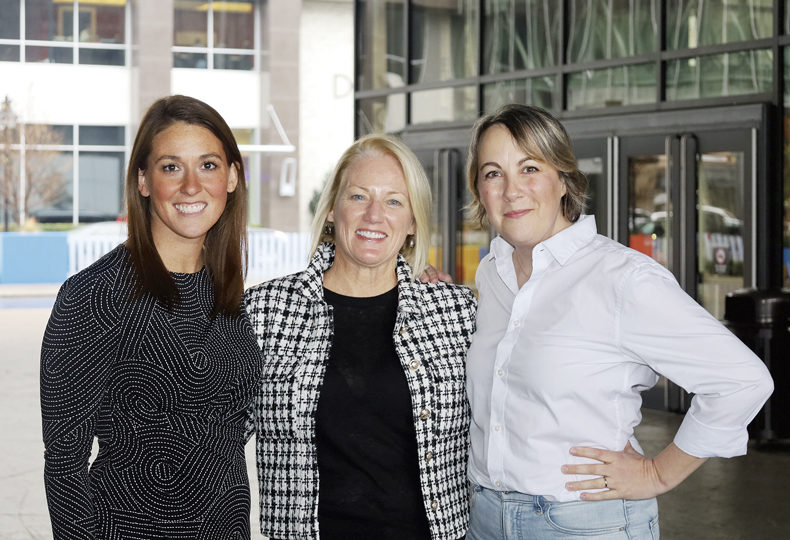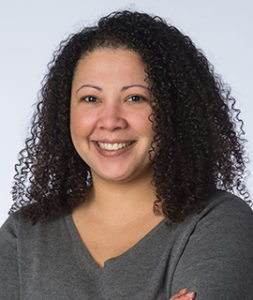
Home » Collaboration takes center stage in Spokane tourism industry
Collaboration takes center stage in Spokane tourism industry
PFD, Visit Spokane, sports commission work together to propel economic growth

Left to right, executives Ashley Blake, Stephanie Curran, and Rose Noble are working together on what’s being called Co-Create Our Strategic Vision & Decision-Making Framework.
| Erica BullockNovember 9, 2023
Three Spokane-based organizations that operate as economic drivers in the community have set aside their once competitive policies to adopt a new combined strategic plan to be publicly announced in the spring.
The leaders of Spokane Public Facilities District, Visit Spokane, and Spokane Sports are working together with Spokane-based FreshVue, a strategic planning and development company, to deepen communication and collaboration between the three entities.
The collaboration could result in higher quality events, instead of a high quantity of events, hosted here. Higher caliber events could provide a greater economic impact than a greater number of events with limited public interest.
Ashley Blake, CEO of Spokane Sports, says, “The key focus has been around how our three organizations are going to work together moving forward and also independently looking at how we’re making choices strategically and thoughtfully.”
Eva Marquette, founder and CEO of FreshVue, says, before this process began, the three organizations had internal systems, infrastructure, and funding designed for competition with the other entities rather than collaboration.
As separate entities with siloed intentions, Marquette says the organizations previously were in competition for venue space and budget financing.
“They are economic drivers in our community and have worked together in different ways,” says Marquette. “But they have never come together in this way to build a cross-collaborative strategy.”
Stephanie Curran, CEO of Spokane Public Facilities District, says the pandemic prompted the three associations to work together on a shared vision for the future.
“For all organizations, who you were before COVID isn’t the same as after COVID,” she says of the pandemic-related changes to employees, operations, and finances.
Curran says that working toward a collaborative plan makes sense because Visit Spokane markets leisure travel and general tourism advocacy, while Spokane Sports markets sports tourism, and the PFD hosts venues for both.
The collaboration, which FreshVue has dubbed Co-Create Our Strategic Vision & Decision-Making Framework, will help the three entities identify and tackle both adaptive and technical challenges that act as barriers to reaching their combined goals, says Marquette.
Technical problems can be solved with expertise or resources, she explains. Adaptive challenges are problems without a specific solution and require long-term commitment to achieve.
Spokane Sports will benefit by tackling adaptive challenges, such as how to increase public awareness of different types of tourism, says Blake.
Visit Spokane will benefit from increased community engagement as well, says Rose Noble, CEO of Visit Spokane.
“Recruiting conventions is just part of what we do,” Noble says, adding that the combined plan highlights Spokane Sports’ event contributions. Acknowledging Spokane Sports will alleviate some pressure for Visit Spokane to fill the facilities with conventions.
Without this collaboration, the city would miss out on a lot of economic opportunities, Marquette says.
In 2022, approximately 9.6 million people visited Spokane County and spent an estimated $1.4 billion, according to data from Visit Spokane published in the Journal’s 2023 Market Fact Book.
Those visitors paid about $219 million in state and local taxes in Spokane County, the Visit Spokane data shows.
Reporting on the hospitality industry’s economic impact in the Spokane community will provide an indication of whether this process is a success, Noble adds.
“We can track the economic impact and want to see a year-over-year increase,” Noble says. “We want to see people calling us to be partners and not us having to call them. The most important thing is going to be us getting on the same reporting system and communication channels. We need to be seamless.”
The PFD will benefit by maximizing its venues for the best matches for year-round event consistency, where currently PFD venues experience lulls of conventions during the winter months and reduced demand for indoor sports events during the summer.
Pinpointing each organization’s individual capabilities and contributions to economic growth is important because the PFD can’t accomplish all of its goals alone, says Curran. The combined plan provides avenues to hold each other accountable in the process.
Executive leadership training is incorporated in this process as well, Marquette notes.
It’s important to note that collaboration doesn’t mean the organizations will always be in agreement, she says.
“This will build the skills to have those hard conversations or to navigate conflicts that come up,” says Marquette.
This process also challenges the three entities to plan for equitable economic growth by using data to help make intentional choices about which vendors they work with and which stories they elevate in the community to contribute to more representation, says Marquette.
The combined plan, which Blake says has an initial estimated cost of $150,000, outlines how each organization can improve community engagement to give the public a better understanding of each entity and what it’s capable of.
With an individual plan to identify what success looks like at each organization, each will work backwards to identify the steps needed to reach their end goal. The combined plan identifies where the three entities align and states how they are capable of contributing to achieve the goal.
Blake says the initial contract with FreshVue has been amended and extended.
Noble says, “FreshVue … is asking questions that prompt us to reveal not only our answers but how we’d go about it, and then seeing where those things align that makes sense. We’re starting with the win, then building back from that to have a plan that’s actually attainable to get that win.”
The end result of the strategic planning process will conclude with a public presentation in the spring announcing the plan details and how collaborating in this way will benefit the community. A 60-page magazine-type booklet will be published for internal use at each organization, and a condensed one-page reference document will be provided for staff at each organization to use as a daily reference tool.
Marquette says the one-page reference document isn’t a list of action items, but a framework for everyday decision making.
Visit Spokane’s former CEO Meg Winchester initiated the collaboration efforts after sharing Visit Spokane’s strategic plan with Curran, explains Blake.
It was Curran, the only executive remaining of the original three that began the process together, who suggested Visit Spokane should collaborate with Spokane Sports and the PFD to achieve its goals.
Both Blake and Noble have committed to continue working together for the benefit of the Spokane community.
Blake says, “We kind of took on the role and energized the process. We’re all committed to carrying it forward and seeing it through because we know that we can strengthen the ties between our organizations and our market will be better for it.”
Latest News Government
Related Articles
Related Products




![Brad head shot[1] web](https://www.spokanejournal.com/ext/resources/2025/03/10/thumb/Brad-Head-Shot[1]_web.jpg?1741642753)
